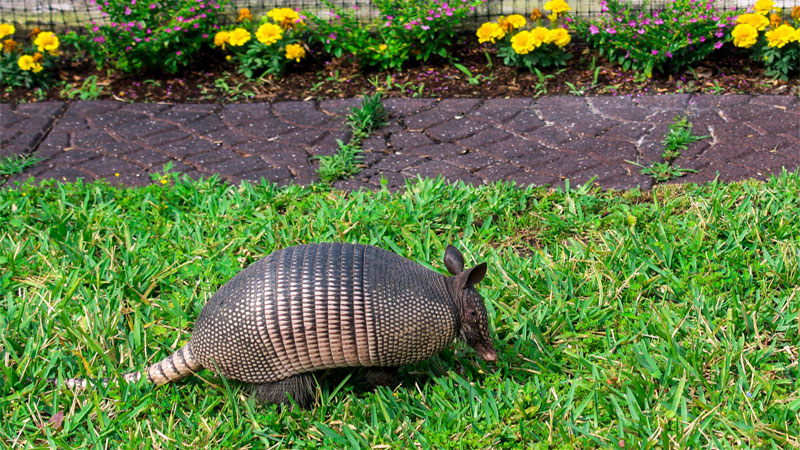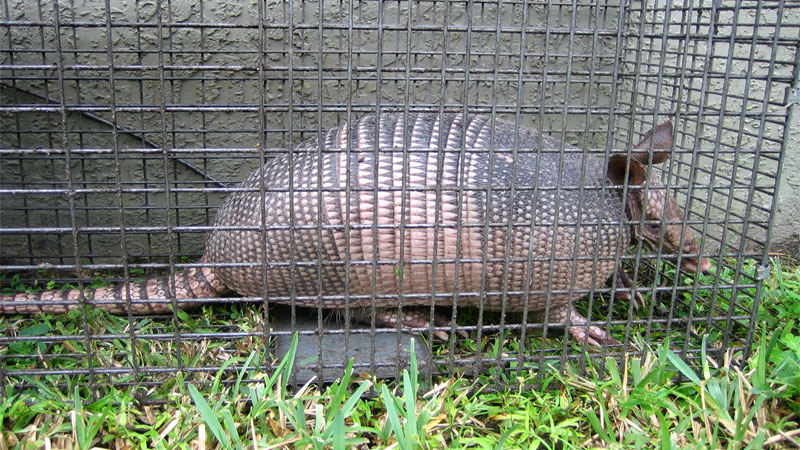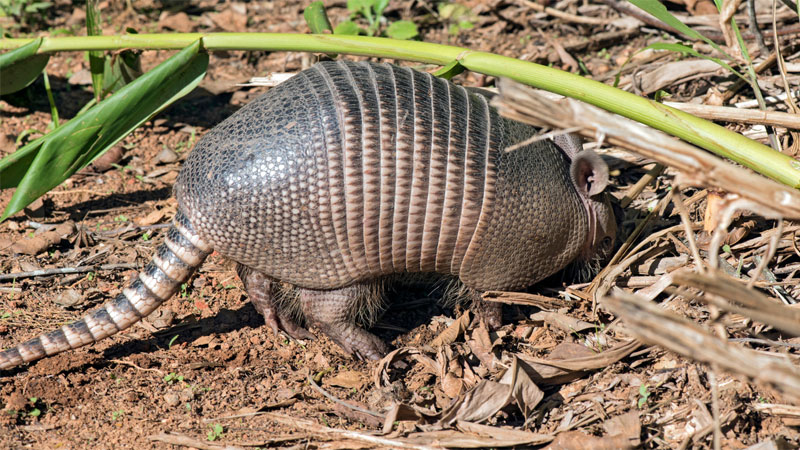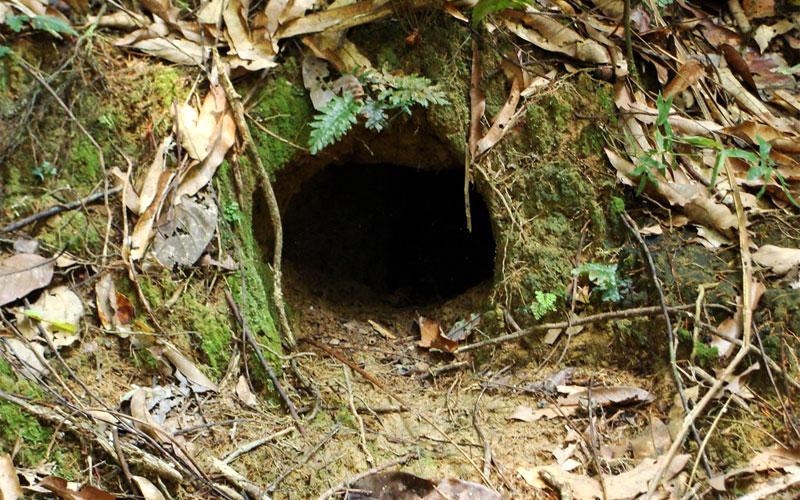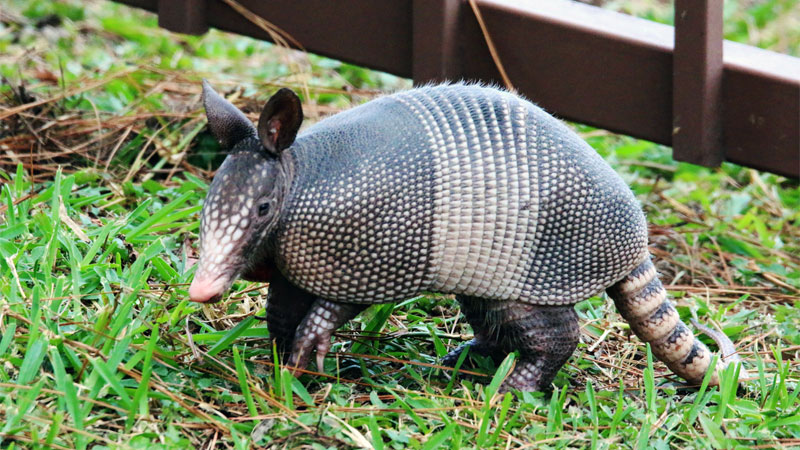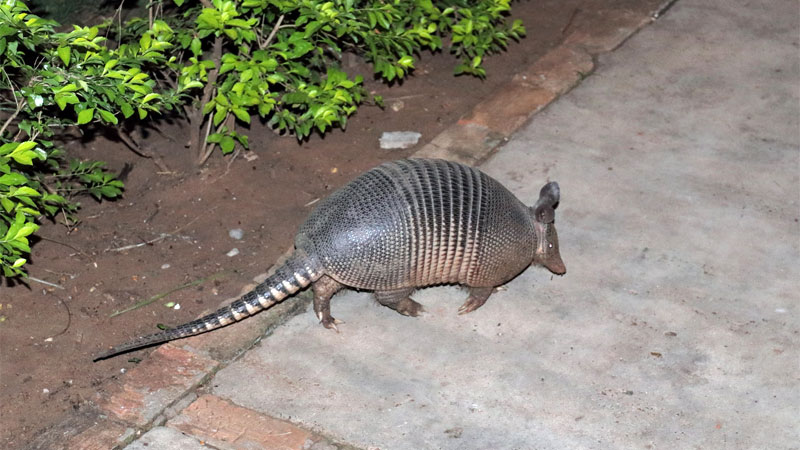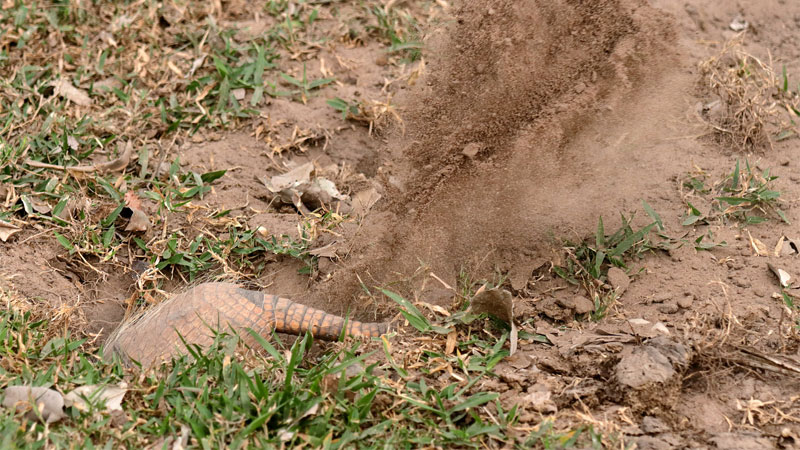Armadillos look like something out of sci-fi, but they’re quite real (and quite a nuisance). Since they can also be a major health risk, let’s begin with a look at how to get rid of armadillos.
We’ll then come back and look at why these critters are so fascinating (and valuable), as well as the risks of keeping them around.
Getting Rid of Armadillos
Between the banging around that keeps you up at night, destruction to your lawn and garden, and potential health risks, it’s pretty obvious you don’t want wild armadillos running around on your property.
In the event you already have one or more nosing about, here’s the lowdown on how to get rid of an armadillo quickly and effectively.
One word of warning: If you plan to come in close contact with a wild armadillo, you should always wear protective clothing and gloves. There’s always a risk it might try to defend itself or there’s fecal matter about. You’ll also want to use disinfectant where the armadillos may have pooped.
See Also: How to Get Rid of Porcupines
Should You Kill an Armadillo?
As you likely already know, we never promote killing a critter unless there’s no better option. While armadillos are considered at no risk in the US, some places may have ordinances against killing one.
Some of these ordinances may revolve around the use of firearms, while others involve cruelty restrictions. If you absolutely need to know how to kill armadillos, be sure you know if it’s legal where you live first. Then spend some time talking to your local wildlife authorities to see what methods are permitted before taking action.
How To Trap an Armadillo
This is by far the best way to get rid of armadillos. You’ll want to invest in a live trap and ensure it’s big enough for the armadillo to fit comfortably inside. Pick a spot near the burrow and lay some bait in the early evening in the spot you plan to put the armadillo trap. The best bait is worms, but fruit or berries also work.
- 32" x 11" x 13" Cage Trap: Ideal for trapping raccons, opossums, cats, rabbits,...
- Built to Last: Made of sturdy galvanized steel for maximum resistance to rust...
- Space-Saving Storage: Collapsible design, easy to fold flat and storage - saves...
Do this for a day or two to ensure the armadillo is interested, but don’t be surprised if the bait isn’t always eaten. Then, after you know the armadillo knows where the bait is, lay your live trap and put the bait inside.
This time, when the armadillo comes out for its evening of foraging, it will end up trapped. You can then easily relocate and release it somewhere far from your home while you armadillo-proof the property. We honestly don’t know how to get rid of armadillos in your yard in a more effective and efficient way than this.
Do Any Home Remedies Work Against Armadillos?
Yes, there are a few remedies that can work when trying to drive an armadillo from your property. These pretty much always come down to strong smells.
For example, sprinkling cayenne pepper around the perimeter of your vegetable garden can often convince the armadillo (and other critters) to look elsewhere.
Another good remedy is to use the two opposing cleaners, white vinegar and ammonia. Ammonia is extremely alkaline and will remind the armadillo of urine. Meanwhile, vinegar is extremely acidic.
Both will overpower the armadillo’s sensitive nose and cause him to flee. You can either use them as a spray or soak a rag and put it near the burrow entrance. Just be careful not to get either on your plants!
However, there’s one method you most certainly should avoid: mothballs. We’ve written an entire guide on this home remedy and why it’s never a good option despite their effectiveness.
How to Get Rid of Armadillos Under Your House
Sometimes critters will choose to make a crawlspace under your house or porch into their new home. But how do you get rid of armadillos who’ve taken up residence in these hard-to-reach places?
Believe it or not, the cage trap is once again your best friend. These little tanks will still rove about at night in search of food sources, meaning it’s easy enough to trap them. Remember to seal any entry points once you’re sure you’ve caught them all.
Professionals
When in doubt, don’t be afraid to contact local animal control, who can trap and remove the armadillos safely.
How to Keep Armadillos Away
While some of the following methods can help you get rid of an armadillo, they’re generally better for keeping them away. Try mixing and matching several of these methods for the best results.
Keep a Clean Yard
Armadillos roam around in search of food, so it stands to reason they won’t hang around an empty buffet table. Make sure to eliminate any unwanted bug infestations.
You can use insecticides or employ beneficial nematodes to keep insect populations under control. Make sure to also keep the yard clear of any fallen or overripe fruit, leftover pet food, or other potential goodies.
Complimentary Gardening
One of the best-kept secrets on how to keep armadillos out of your yard or garden is to use complimentary gardening (AKA companion planting). This is the practice of using plants with specific properties to benefit nearby plants.
For armadillos, consider planting peppermint, sage, lemongrass, or garlic. While great for your kitchen, armadillos will hate the smell.
Fencing
Ground fences are an effective barrier against armadillos. Unfortunately, most people make the mistake of building them only above ground. For an effective barrier, you also have to go below ground.
To stop armadillos, the fence needs to extend approximately 18 inches below ground. Above ground, 24 inches should be a good height to stop both armadillos and a lot of other critters.
For best results, make sure the top angles out around 45 degrees. This angle will ensure the fence can’t be climbed from the outside. Sonic fences will also work.
How to Get Rid of Armadillo Holes
Finally, let’s discuss how to get rid of armadillo burrows or holes. This is best done once you’ve removed their inhabitants. Doing so will not only deter armadillos from returning, it can also prevent other critters from taking up residence.
The easiest method is to fill the holes with gravel, although course sand can also work in a pinch. We don’t recommend you fill armadillo holes with water, as this can lead to some unwanted side effects for your property.
Getting to Know Armadillos
When we talk about armadillos in the US, there’s only one native species present to discuss. Luckily, this is also arguably the coolest: the nine-banded armadillo (Dasypus novemcinctus).
However, there are currently 21 known species of armadillos overall, all originating from South America.
Identifying US Armadillos
As mentioned, the nine-banded armadillo is the only type found in the US and this curious species is sometimes referred to as the common long-nosed armadillo.
What Do They Look Like?
These little guys are among the largest armadillos, measuring up to 42 inches long, with half of that being tail, and around 9.8 inches tall. While most will only weigh a little over 14 pounds, the largest can weigh as much as 22 pounds.
The common long-nosed armadillo has a longer snout, long rabbit-like ears, and tough, scaly plating that protects the back, sides, head, tail, and the outer parts of the legs.Ironically, the name armadillo is Spanish for “little armored one”, but the Mēxihcah (what we now call Aztecs) called it āyōtōchtli, meaning “turtle-rabbit”, which is quite the accurate description.
The inner portion of the legs and belly have thick, tough skin covered in coarse hair. Their front paws have a longer middle claw, making it easier to dig. With a body that ranges from gray to brown, these little critters can live up to 10 years in the wild and blend right in with bare soil or rock.
Nine-Banded Fun Facts
While there are six subspecies, most are in South or Central America. Contrary to the name “nine-banded”, the various subspecies will vary from 7 to 11 bands. There’s surprisingly little genetic diversity in the US population.
One sad fact is that the nine-banded armadillo can’t roll into a ball like its three-banded cousin, but it has a different ability which is just as neat – it can pull air into its intestines, allowing it to float on water.
Even more interesting is that the armadillo can keep its snout submerged in soil or water for up to six minutes at a time. Thus, it’s not unusual to see an armadillo dive like a submarine and skitter across a riverbed.
Dillo Clones
Another area where armadillos have humans beat is they’ve mastered the art of cloning long before we even thought to try it. A female armadillo will give birth to four identical clones without fail. This has some interesting implications, mind you.
For example, each clone will have the exact same immunities and resistances as the mother, which makes them a much hardier critter. However this also reduces the genetic diversity of a population.
While not as big of a problem in South America, it’s clear that only a few nine-banded armadillos migrated into the US due to the relatively small variations in their genes. As such, any genetic disorders that are passed down will affect all four young, which can increase the likelihood of such defects becoming more widespread.
What Parts of the US Do Armadillos Inhabit?
Armadillos are best-suited for subtropical environments. However, as we’re entering a minor heat age, they’re able to slowly expand their territory to cooler regions.
Currently, they range from Texas to Florida, with a northern range extending into Nebraska and the southern portions of Illinois and Indiana. This will likely be the extent of their northern expansion. Further north and they wouldn’t survive harsh winters or especially arid conditions.
However, it is theorized they’ll be able to continue expanding along the Eastern seaboard as far north as Connecticut.
What Time of Night Do Armadillos Come Out?
This varies a bit depending on the weather. Armadillos need 16 hours of sleep and are normally crepuscular, meaning they’re active at dawn and dusk. However, as the weather warms, their active period may go from late evening into early night.
In the hottest months, they’re often completely nocturnal. Their activity is then usually around 2:00 to 5:00 AM when it’s coolest. In winter, they’re actually known to come out during the day when it’s warm enough to forage.
What Do Armadillos Eat?
Armadillos are primarily insectivores. They prefer such tasty morsels as grubs and worms, with a side of bugs and insects. However, they’re also known to forage fruit or roughage. On rare occasion will scavenge carcasses or even eat something as large as a snake or rabbit.
Armadillos are non-territorial and will migrate long distances in search of food, meaning today’s visitor may not be tomorrow’s.
Do Armadillos Bite?
Armadillos are shy critters and prefer to avoid confrontation. Their teeth are peg-like and unable to do much damage, even if they try to bite you in self-defense. Likewise, their claws are dull to make them more efficient diggers than defenders.
Instead, their main defense mechanism is to squat and remain very still, hoping a predator will mistake them for a rock.
If this doesn’t work, they’ll jump four feet straight up in the air! This startles the predator long enough for the armadillo to escape at surprising speed to the nearest hiding spot.
Do Armadillos Roll?
The only armadillo capable of rolling into a ball is the three-banded armadillo. However, much like hedgehogs, this doesn’t give them the ability to roll around like a ball.
Ironically, the reason other species like the long-nosed armadillo can’t curl into a ball is because they have too many bands, which one would think would have the opposite effect.
Are Armadillos Really That Stupid? (or Critters That Go Bump in the Night)
What makes armadillos a pest for many is the noise of them bouncing off of objects in your backyard or getting into a poorly-placed trash can. They may even knock over some potted plants if they’re within reach. Watching armadillos bump into things or run into a tree at full speed like this might make them seem really stupid, but this isn’t the case.
In fact, armadillos have extremely poor eyesight and rely on their sense of smell and touch to explore the world around them. Under the right circumstances, they can be quite clever, but the inability to see where they’re going can lead to pure slapstick comedy gold.
Burrowing and Excavating: The REAL Armadillo Problem
As annoying as the sound of them running into your trash can might be, the real problem is that armadillos burrow in search of their prey. They prefer looser soil and are known to excavate entire gardens in search of grubs and worms.
As a result, they’re more likely to destroy well-manicured lawns than unkempt and rocky yards. These excavations tend to be around three to five inches wide and up to three inches deep.
Not only can this uproot plants and tear up your lawn, but armadillos setting up shop on your property will likely create their burrow under the house or other structures.
These burrows can be up to 15 feet long and sometimes result in structural damage similar to damage caused by groundhogs. This can also lead to damaging underground pipes and wires.
While solitary for most of the year, armadillos will raise their young in the burrows. They’ll also spend as much as 65% of their time hiding inside – especially during the winter or hottest portions of summer.
Dillophilia
Dillophilia is the love of armadillos, and “dillering” is the popular term used for catching or collecting armadillos and armadillo memorabilia. There’s just something about these critters that make a lot of people forget about the bad reputation. In fact, they’re often kept as exotic pets.
Texas is considered the heart of dillomania, and there are even campaigns to make the armadillo the official state animal. There’s also the IALA (International Armadillo Lovers Association), which has as one of its rules the stipulation that members cannot eat armadillo meat.
And yes, armadillos are a popular food in many locations, bearing the nicknames “Texas turkey” and “Hoover hog”. In fact, there are entire cookbooks devoted to armadillos, although we strongly recommend you get them from a breeder and avoid wild armadillo meat due to the possible risk of disease.
Finally, Kansas City used to hold an annual event called the Kidney Foundation Armadillo Races (it’s unknown whether this event still exists, sadly). As the name suggests, dillophiles could watch a bunch of armadillos race, and the proceeds would go towards kidney research.
Read Also: How to Get Rid of Wild Turkeys
Armadillo Health Risks
Finally, we have to address one of the biggest concerns posed by armadillo infestations – health risks.
Armadillos have a nasty reputation for spreading disease, but this is generally exaggerated. That said, they do still pose a health risk and should be handled with some degree of caution.
Fecal Contamination
Armadillo feces often contains salmonella, a bacteria which is quite common but can still cause food poisoning and may be dangerous for immunosuppressed individuals or small children. It can also contain parasitic worms or other diseases commonly found in excrement.
Leprosy
Hansen disease is a form of leprosy that can be transmitted to humans through armadillo bites, scratches, or feces, but this is extremely rare. Armadillos in the US have a rather small chance of containing the two bacteria that are known to cause leprosy.
According to the Mayo Clinic, most people these days have an immunity to the disease unless they have some form of immunodeficiency. Thankfully, leprosy is now treatable even if you do catch it.
Rabies
However, the most severe risk is that armadillos are one of many species that can transmit rabies. The risk of getting rabies from an armadillo is about as low as getting it from rabbits, feral rats, or opossums. Compare this to the much higher risk when in contact with bats or raccoons.
Armadillo Health… Benefits?
The good news is that armadillos are also a valuable ally, as they’re the only non-human critter to carry leprosy. Not only are they being studied not only to find a cure for this disease, but also are used to produce the rabies vaccine.
- How to Get Rid of Hawks - March 8, 2024
- How to Get Rid of Pill Bugs (Rolly Pollies) - March 1, 2024
- How to Get Rid of Groundhogs (Woodchucks) - February 5, 2024

